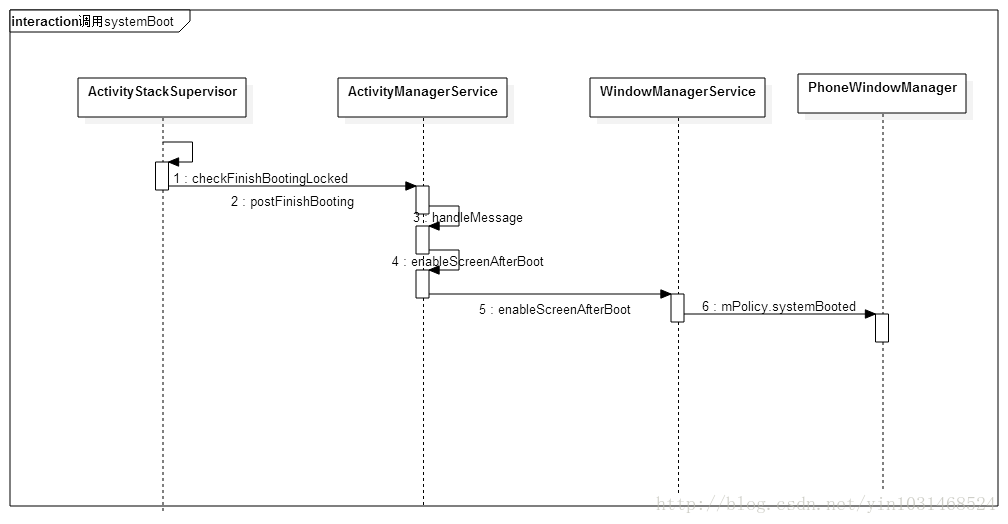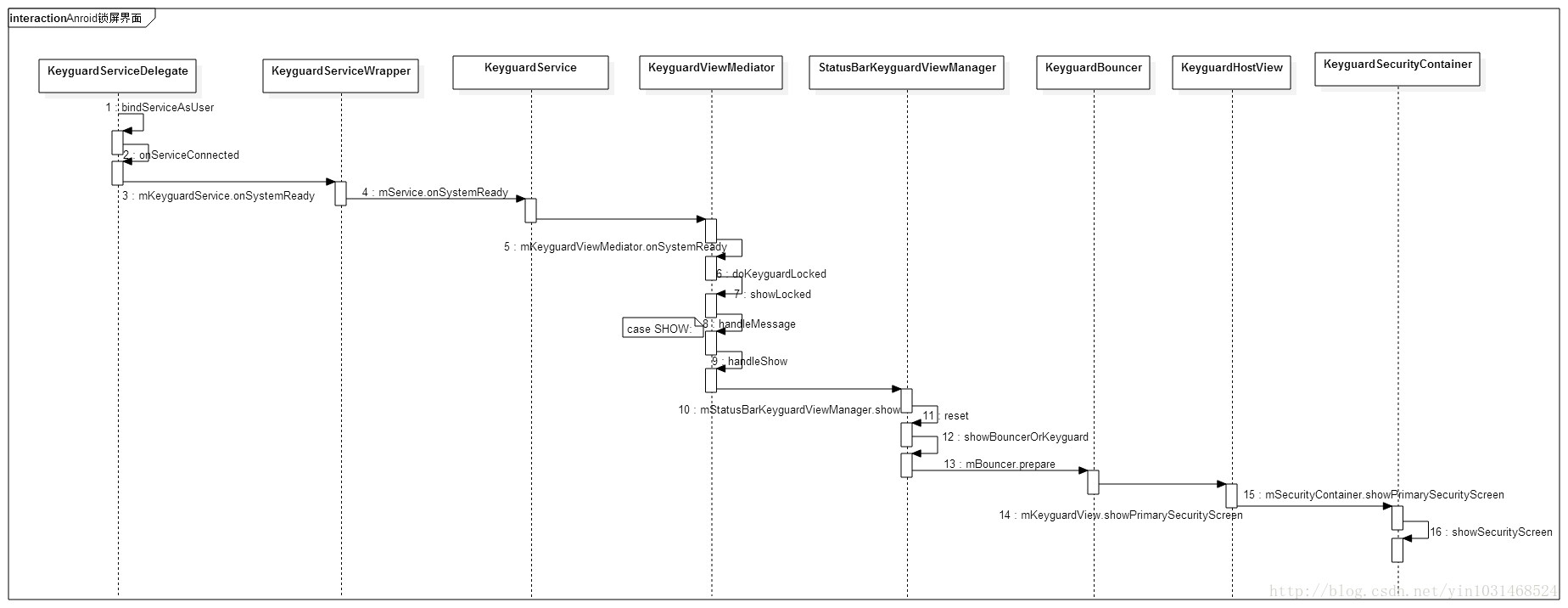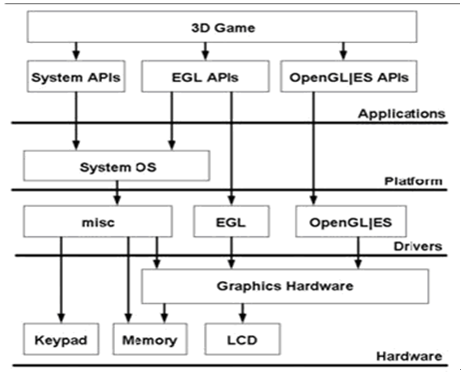編輯:關於Android編程
Android 7.1.1 鎖屏界面啟動流程。前幾天遇到一個低概率復現鎖屏界面不顯示,只顯示狀態欄的問題,跟了下鎖屏界面啟動顯示的流程,在這分享下,也方便以後自己查看。前面簡單介紹了下Zygote啟動流程,Zygote進程啟動後會首先創建一個SystemServer進程,SystemServer進程在調用startOtherServices同時也會調用WindowManagerService的systemReady()方法
//frameworks/base/services/java/com/android/server/SystemServer.java
private void startOtherServices() {
...
wm = WindowManagerService.main(context, inputManager,
mFactoryTestMode != FactoryTest.FACTORY_TEST_LOW_LEVEL,
!mFirstBoot, mOnlyCore);
...
try {
wm.systemReady();
Slog.i("jason11", "SystemServer wm.systemReady");
} catch (Throwable e) {
reportWtf("making Window Manager Service ready", e);
}
...
}
在WindowManagerService中直接調用了PhoneWindowManager裡的systemReady()
//frameworks/base/services/core/java/com/android/server/wm/WindowManagerService.java
//final WindowManagerPolicy mPolicy = new PhoneWindowManager();
public void systemReady() {
mPolicy.systemReady();
}
在PhoneWindowManager的systemReady()會根據一個Boolean值bindKeyguardNow來決定是否綁定keyguard service
//frameworks/base/services/core/java/com/android/server/policy/PhoneWindowManager.java
/** {@inheritDoc} */
@Override
public void systemReady() {
mKeyguardDelegate = new KeyguardServiceDelegate(mContext);
mKeyguardDelegate.onSystemReady();
readCameraLensCoverState();
updateUiMode();
boolean bindKeyguardNow;
synchronized (mLock) {
updateOrientationListenerLp();
mSystemReady = true;
mHandler.post(new Runnable() {
@Override
public void run() {
updateSettings();
}
});
bindKeyguardNow = mDeferBindKeyguard;
if (bindKeyguardNow) {
// systemBooted ran but wasn't able to bind to the Keyguard, we'll do it now.
mDeferBindKeyguard = false;
}
}
if (bindKeyguardNow) {
mKeyguardDelegate.bindService(mContext);
mKeyguardDelegate.onBootCompleted();
}
mSystemGestures.systemReady();
}
看到這裡,可能會想到如果bindKeyguardNow為false就會不綁定,後面通過繼續跟蹤發現在PhoneWindowManager的systemBooted()裡也會去綁定keyguard service,如果在systemBooted裡綁定了就不在systemReady裡再去綁定,自己測試的時候是在systemBooted綁定的
//frameworks/base/services/core/java/com/android/server/policy/PhoneWindowManager.java
/** {@inheritDoc} */
@Override
public void systemBooted() {
boolean bindKeyguardNow = false;
synchronized (mLock) {
// Time to bind Keyguard; take care to only bind it once, either here if ready or
// in systemReady if not.
if (mKeyguardDelegate != null) {
bindKeyguardNow = true;
} else {
// Because mKeyguardDelegate is null, we know that the synchronized block in
// systemReady didn't run yet and setting this will actually have an effect.
mDeferBindKeyguard = true;
}
}
if (bindKeyguardNow) {
mKeyguardDelegate.bindService(mContext);
mKeyguardDelegate.onBootCompleted();
}
synchronized (mLock) {
mSystemBooted = true;
}
startedWakingUp();
screenTurningOn(null);
screenTurnedOn();
}
下面就通過如下的時序圖看看是如何調用到systemBooted的,就不在一步步跟了

通過上面的分析知道,無論是在systemReady或systemBooted,都調用了KeyguardServiceDelegate對象的bindService方法,下面就以這個方法開始,看看鎖屏界面是怎麼顯示出來的,先看看下面的時序圖,再來分步講解

1、先來看看在KeyguardServiceDelegate如何綁定KeyguardService的
//frameworks/base/services/core/java/com/android/server/policy/keyguard/KeyguardServiceDelegate.java
public class KeyguardServiceDelegate {
...
public void bindService(Context context) {
Intent intent = new Intent();
final Resources resources = context.getApplicationContext().getResources();
final ComponentName keyguardComponent = ComponentName.unflattenFromString(
resources.getString(com.android.internal.R.string.config_keyguardComponent));
intent.setComponent(keyguardComponent);
if (!context.bindServiceAsUser(intent, mKeyguardConnection,
Context.BIND_AUTO_CREATE, UserHandle.OWNER)) {
Log.v(TAG, "*** Keyguard: can't bind to " + keyguardComponent);
mKeyguardState.showing = false;
mKeyguardState.showingAndNotOccluded = false;
mKeyguardState.secure = false;
synchronized (mKeyguardState) {
// TODO: Fix synchronisation model in this class. The other state in this class
// is at least self-healing but a race condition here can lead to the scrim being
// stuck on keyguard-less devices.
mKeyguardState.deviceHasKeyguard = false;
hideScrim();
}
} else {
if (DEBUG) Log.v(TAG, "*** Keyguard started");
}
}
...
}
在bindService中調用了bindServiceAsUser綁定指定intent的service,config_keyguardComponent的定義如下
//frameworks/base/core/res/res/values/config.xml
com.android.systemui/com.android.systemui.keyguard.KeyguardService
當綁定成功後會調用mKeyguardConnection裡的onServiceConnected方法
//frameworks/base/services/core/java/com/android/server/policy/keyguard/KeyguardServiceDelegate.java
public class KeyguardServiceDelegate {
...
private final ServiceConnection mKeyguardConnection = new ServiceConnection() {
@Override
public void onServiceConnected(ComponentName name, IBinder service) {
if (DEBUG) Log.v(TAG, "*** Keyguard connected (yay!)");
mKeyguardService = new KeyguardServiceWrapper(mContext,
IKeyguardService.Stub.asInterface(service));
if (mKeyguardState.systemIsReady) {
// If the system is ready, it means keyguard crashed and restarted.
mKeyguardService.onSystemReady();
// This is used to hide the scrim once keyguard displays.
if (mKeyguardState.interactiveState == INTERACTIVE_STATE_AWAKE) {
mKeyguardService.onStartedWakingUp();
}
if (mKeyguardState.screenState == SCREEN_STATE_ON
|| mKeyguardState.screenState == SCREEN_STATE_TURNING_ON) {
mKeyguardService.onScreenTurningOn(
new KeyguardShowDelegate(mDrawnListenerWhenConnect));
}
if (mKeyguardState.screenState == SCREEN_STATE_ON) {
mKeyguardService.onScreenTurnedOn();
}
mDrawnListenerWhenConnect = null;
}
if (mKeyguardState.bootCompleted) {
mKeyguardService.onBootCompleted();
}
if (mKeyguardState.occluded) {
mKeyguardService.setOccluded(mKeyguardState.occluded);
}
}
@Override
public void onServiceDisconnected(ComponentName name) {
if (DEBUG) Log.v(TAG, "*** Keyguard disconnected (boo!)");
mKeyguardService = null;
}
};
...
}
 詳解Android應用開發中Scroller類的屏幕滑動功能運用
詳解Android應用開發中Scroller類的屏幕滑動功能運用
今天給大家介紹下Android中滑屏功能的一個基本實現過程以及原理初探,最後給大家重點講解View視圖中scrollTo 與scrollBy這兩個函數的區別 。
 ANDROID L——Material Design詳解(動畫篇)
ANDROID L——Material Design詳解(動畫篇)
Android L: Google已經確認Android L就是Android Lollipop(5
 Android程序 依賴庫引用Gson 報java.lang.NoClassDefFoundError: com/google/gson/Gson 解決方法
Android程序 依賴庫引用Gson 報java.lang.NoClassDefFoundError: com/google/gson/Gson 解決方法
Android 程序所依賴一個Library程序B , B 程序中用到格式化json串,轉換成標准json串的要求 public static Strin
 Android開發 OpenGL ES繪制3D 圖形實例詳解
Android開發 OpenGL ES繪制3D 圖形實例詳解
OpenGL ES是 OpenGL三維圖形API 的子集,針對手機、PDA和游戲主機等嵌入式設備而設計。 Ophone目前支持OpenGL ES 1.0 ,OpenGL